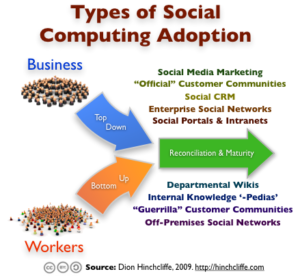As social business models enter the mainstream, we are starting to — as an industry — get a broad sense of how the real-world adoption really works in these new digital arenas for collaboration and communication in the enterprise.
And the lesson here is that social computing — the combination of new social business processes and the tools required to support them — offers up a very different model for how workers, trading partners, and even customers will engage with these environments and with each other.
What we are increasingly finding is that the classical business world of official “systems of record” and formal roll-out — matched with mandatory adoption — is often in almost direct opposition to successful social computing and Enterprise 2.0, in all their various forms. Part of this is because participation in social systems is usually open, has (sometimes fierce) competition from other internal channels like e-mail and IM, and is ultimately optional.
Other reasons have to do with human nature and social dynamics, which can be messier and less predictable than rigid policy and procedure often admits, despite being rich and fertile soil for innovation, change, and improvement.

In the end, social computing adoption appears to work better with a different, more inclusive and collaborative approach than classical software adoption. This also highlights two very different genesis scenarios that we can use to identify the best strategies to gain both participation, the gold standard metric of social systems, as well as proper situation and uptake within an enterprise.
Related: 12 Rules For Bringing ‘Social’ To Your Business
In general, there are two primary ways that social computing begins inside an organization:
Official top-down adoption. This is when an organization, or part of an organization, decides that it wants to start using social computing models to address business problems. This typically manifests itself as social media marketing, company-sponsored customer communities, social CRM, enterprise social networks, or social portals and intranets. The organization here is responsible for dealing with policy and governance as well as encouraging users to participate and building successful communities, internally and/or externally. Because of the nature of social computing however, mandates for use must be replaced with techniques that elicit participation and open collaboration.
Less official, bottom-up adoption. In this model, a department, team, or sometimes even a lone user, decides to start using social computing tools to solve a local problem. There is a high inherent validity of actual workers solving real problems with social computing in an non-contrived manner. Combine this with the fact that the network effect of many Enterprise 2.0 tools is much higher than most traditional software solutions, and we see the following: Grassroots efforts often spread, often quite quickly, to adjacent departments and sometimes across the entire organization by virtue of the value they are creating. This scenario is typically represented by departmental wikis and “pedias”, guerrilla customer communities (often started by customers given no other choice), and participation in off-premises social networks. The business eventually has to decide with to support, stop, or absorb the effort into a larger, formal initiative.
Key Point:With one model, you get adoption but often not validity, while in the other you get validity but often not adoption.
For now, I’m seeing both paths as viable and frequently occurring starting points with social computing, but reconciliation of the two is often the best path to both validity and adoption as we saw with the Jacob Nielsen study recently. The whole conversation about community management however is really where the long-term implications of community-based power structures is centered and is becoming ground zero for understanding how to be successful with either model.
The bottom line is that organizations need to allow both adoption models to succeed when appropriate and often bring them together to get the best of both types of adoption models.





